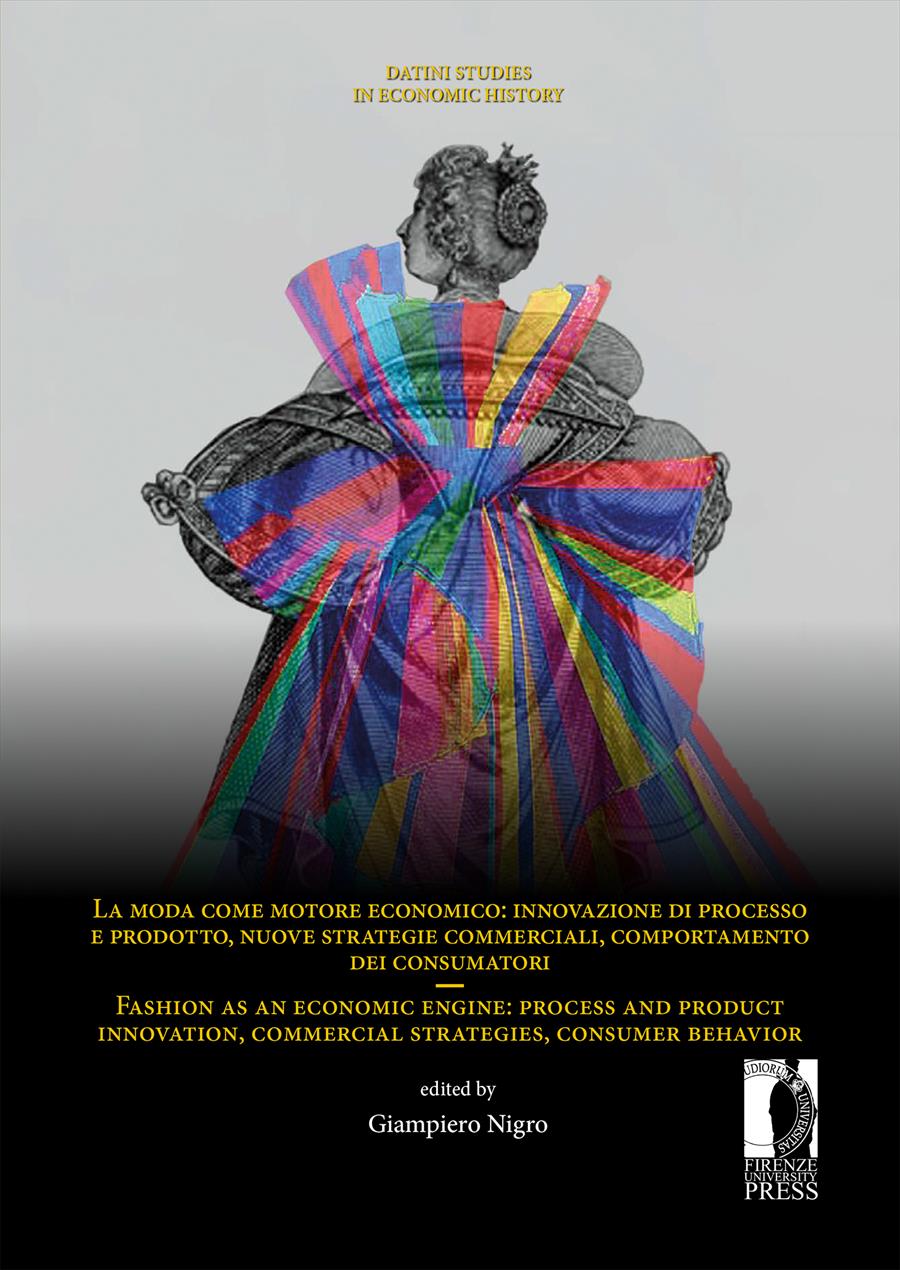Prolusione
- Maria Giuseppina Muzzarelli
- © 2022 Author(s) |
- CC BY 4.0
- DOI: 10.36253/978-88-5518-565-3.02
Divided into ten points, this paper aims to illustrate how fashion produced modernity, understood as valuing the present, especially its progressive and evolving elements. A process that focused on amplifying “personal visibility”, and in which the abilities of tailors played a crucial role. The effects on the economy of “modern” fashion, born in the Middle Ages, have been significant. Since the thirteenth century, treatisers and preachers, as well as legislators, focused on the way people dressed as a means to regulate society, while artisanal shops invented, ever so often, new objects and prepared unseen social and political scenarios. For all these and many other reasons, we can state that fashion moved and was a metaphor of modernity.
- Keywords:
- Economic history,
- fashion,
- textile history,
- preindustrial economy,
University of Bologna, Italy - ORCID: 0000-0003-4399-5215
- Belfanti, Carlo Marco. 2008. Civiltà della moda. Bologna: il Mulino.
- Blanc, Odile. 1997. Parades et parures. L’invention du corps à la fin du Moyen Age. Paris: Gallimard.
- Bocchi, Francesca. 1984. Trasferimenti di lavoratori e studenti a Bologna nel basso Medioevo, in Forestieri e stranieri nelle città basso-medievali, 249-61. Firenze: Libreria Editrice Salimbeni.
- Capestrano da, Giovanni. 1956. Trattato degli ornamenti specie delle donne, a cura di Aniceto Chiappini. Siena: Cantagalli.
- Colombo, Diana 2010. Alle origini della moda. Dal costume nazionale al sistema della moda. Reggio Emilia: Diabasis.
- Gherardi Dragomanni, Francesco. 1845, Cronica di Giovanni Villani a miglior lezione ridotta, l. XII, cap. IV, 12. Firenze: Sansone Coen.
- Hunt, Alan. 1996. Governance of Consuming Passion. A History of Sumptuary Law. New York: St. Martin’s Press.
- Kovesy, Catherine. 2002. Sumptuary law in Italy, 1200-1500. Oxford: Clarendon Press. DOI: 10.1093/acprof:oso/9780199247936.001.0001
- Lampugnani, Agostino. 1648. Della carrozza da nolo, o vero del vestire e usanze alla moda, Milano: per Ludovico Monza.
- Lemire, Beverly. 2018. Global trade and the transformation of consumer cultures. The material world remade, c.1500-1820. Cambridge: Cambridge University Press. DOI: 10.1017/9780511978814
- Muzzarelli, Maria Giuseppina, a cura di. 2002. La legislazione suntuaria. Secoli XIII-XVI. Emilia-Romagna. Roma: Ministero per i Beni e le Attività Culturali.
- Muzzarelli, Maria Giuseppina. 2003. “Le leggi suntuarie.” In Storia d’Italia. La moda, a cura di Carlo Marco Belfanti, e Fabio Giusberti, 180-220. Torino: Einaudi (Annali, 19).
- Muzzarelli, Maria Giuseppina. 2009. “Reconciling the privilege of a few with the common good. Sumptuary laws in Medieval and Early Modern Europe,” The Journal of Medieval and Early Modern Studies 39, 3 (fall): 597-617. DOI: 10.1215/10829636-2009-006
- Muzzarelli, Maria Giuseppina. 2019. “Questioni di limite: predicare la misura.” In Cahiers d’études italiennes. Éditions littéraires et linguistiques de l'université de Grenoble, 29, L’art de la prédication au XVe siècle: efficacité rhétorique et figurative. DOI: 10.4000/cei.5832
- Muzzarelli, Maria Giuseppina. 2020. Le regole del lusso. Apparenza e vita quotidiana dal Medioevo all’Età Moderna. Bologna: il Mulino.
- Nico Ottaviani, Maria Grazia, a cura di. 2005. La legislazione suntuaria. Secoli XIII-XVI. Umbria. Roma: Ministero per i Beni e le attività culturali.
- Olson, Kristina M. 2015. “Uncovering the historical body of Florence. Dante, Forese Donati, and sumptuary legislation.” Italian Culture, XXXIII, 1: 1-15. DOI: 10.1179/0161462214Z.00000000030
- Orlandi, Angela. 2012. “Le merciaie di Palma. Il commercio dei veli nella Maiorca di fine Trecento.” In Dare credito alle donne. Presenze femminili nell’economia tra Medioevo ed Età Moderna, a cura di Giovanna Petti Balbi, e Paola Guglielmotti, 149-66. Asti: Centro Studi Renato Bordone sui Lombardi, sul credito e sulla banca.
- Paulicelli, Eugenia, a cura di. 2006. Moda e moderno. Dal Medioevo al Rinascimento. Roma: Meltemi.
- Piponnier, Françoise. 1989. “Une revolution dans le costume masculinau XIV siècle.” In Le vetement. Histoire, archéologie et symbolique vestimentaires au Moyen Age, a cura di Michel Pastoreau, 225-242. Paris: Cahiers du Léopard d’or.
- Reiney, Ronald E. 1985. Sumptuary legislation in Renaissance Florence. Columbia University: unpublished PhD dissertation.
- Riello, Giorgio. 2019, “The world in a book: The creation of the global in sixteenth-century European costume books.” Past & Present, 242, 14 (November): 281-317. DOI: 10.1093/pastj/gtz047
- Riello, Giorgio, e Rublack Ulinka, a cura di. 2019. The right to dress. Sumptuary Laws in a global perspective. c.1200-1800. Cambridge: Cambridge University Press. DOI: 10.1017/9781108567541
- Simmel, Georg. 1998. La moda, a cura di Lucio Perucchi, 40-41. Milano: Mondadori ( “Die Mode”, in Philosophische Kultur: gesammelte Essais, Leipzig: Kinkhardt, 1895).
- Tosi Brandi, Elisa 2017. L’arte del sarto nel Medioevo. Quando la moda diventa un mestiere. Bologna: il Mulino.
- Trentmann Frank, Empire of things. How we became a world of consumers, from the fifteenth century to the twenty-first. London: Allen Lane.
- Vecellio, Cesare. 1590. Habiti antichi et moderni delle diverse parti del mondo. Venezia: Damian Zenaro.
- Wilson, Laurel Ann. 2011 “De novo modo”: the birth of fashion in the Middle Ages. Fordham University: unpublished PhD dissertation.
- Zanoboni, Maria Paola. 2016. Donne al lavoro nell’Italia e nell’Europa medievali (secoli XIII-XV), Milano: Jouvance.
Chapter Information
Chapter Title
Prolusione
Authors
Maria Giuseppina Muzzarelli
Language
Italian
DOI
10.36253/978-88-5518-565-3.02
Peer Reviewed
Publication Year
2022
Copyright Information
© 2022 Author(s)
Content License
Metadata License
Bibliographic Information
Book Title
La moda come motore economico: innovazione di processo e prodotto, nuove strategie commerciali, comportamento dei consumatori / Fashion as an economic engine: process and product innovation, commercial strategies, consumer behavior
Editors
Giampiero Nigro
Peer Reviewed
Number of Pages
422
Publication Year
2022
Copyright Information
© 2022 Author(s)
Content License
Metadata License
Publisher Name
Firenze University Press
DOI
10.36253/978-88-5518-565-3
ISBN Print
978-88-5518-564-6
eISBN (pdf)
978-88-5518-565-3
eISBN (xml)
978-88-5518-566-0
Series Title
Datini Studies in Economic History
Series ISSN
2975-1241
Series E-ISSN
2975-1195
